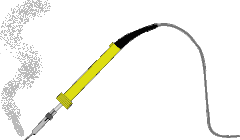That's the front panel. Glenn's kids and grand kids liked sitting on his lap while he played radio and putting stickers on it
This is one of the best HB2HB contacts I've had. I was just getting ready to sign off on 40 meters when I heard someone calling me. It was KU4NO. I thought I'd just give the OM a quick report. Then he said, "My rig is homebrew too." And wow, it is indeed! When he said this my first thought was that maybe this was a kit rig, but no, it turns out that this rig is the scratchyist of scratch-built rigs -- true hardcore hardrock homebrew.
I checked my log. I had worked Glenn once before, in December 2001. I was in the Azores. And he was using this same rig. Glenn told me that for all these years, this has been his ONLY rig. A friend gave him a modern commercial rig, but he prefers this one. I understand completely.
At first, Glenn made me promise not to share the pictures with anyone. He seemed a bit embarrassed by his creation. I told him that SolderSmoke readers would appreciate his rig and see the value of it. I explained that we all have soldering iron scars on our fingers, and clothing that has been stained by ferric chloride. We LIKE ugly. It took some persuasion, but I got him to agree to let me share this with the group.
Glenn reports it is based on a "5 band transceiver" circuit in the 1976 or 1977 handbook. (i don't have one and can't find it on-line -- can anyone get us a copy of the schematic and article?)
So I say THREE CHEERS for Glenn KU4NO and his homebrew 5 band transceiver. For me, the stickers are the most important feature of this rig. Please e-mail me your comments on Glenn's rig - in an effort to let him know how much we appreciate and understand his effort, I will pass them on to him. I wish more hams would follow his example.
Glenn wrote:
Oh well I'm not too concerned about who sees it.
I just wouldn't want to cause anyone to follow my example.
Maybe you could call it "a tornado goes through a junkyard."
Just kidding around ...no restrictions...I'm sure it will be forgotten soon ..... but I will be innocent of any harm caused by it.
Its the only rig I've ever owned when we contacted before it was with it.
The inspiration article in the 76 or 77 handbook is worth a look.
The VFO tuning cap and mount came from a CB "slider" one of my brother-in-laws gave me it seems to work well
Glenn
Picture Above: top view upper left power out two IRF 510s from w2eby ( I think) 30+ to 60+ watts across HF love this circuit, small board connected at right angle is 1/2 watt driver from Harrys Homebrew page 2n2222 driving 4 2n2222s beautiful circuit
lower left power transformer
one of two wafer band switches in middle .... under wafer switch is hf mixer and single balanced mixer to generate ssb
LO from progressive receiver top right ... heat sink just to left and lower unused voltage regulator
RF amp and wafer switch lower right used for transmit and receive
LO tuning cap and hf mixer modulator circuit
RF amp
Crystals for mixing, BFO, old detector circuit. Old circuit that repeated CQ call, chip from Radio Shack
Some micro relays ...... audio amp at bottom and two switchable compressor circuits one using an SL 1626 and one lifted from a President model CB radio and some filter caps
New IF AGC audio detector uses three ca 3028As from 67 handbook schematic is wrong can you find the mistakes? it was printed wrong twice i use an s meter with it
Close up of power output and lower left rf output filters




